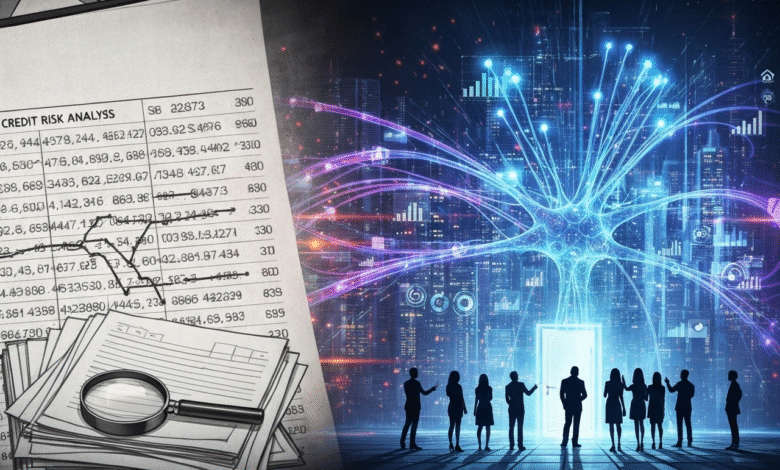From Traditional to AI: The Evolution of Credit Risk Analysis

▼ Summary
– Credit risk analytics has evolved from manual spreadsheet methods to sophisticated systems using AI, automation, and real-time data.
– Traditional credit models relied on fixed criteria like financial statements and the “five Cs,” but were slow and lacked personalization.
– Digitization enabled faster processing, dynamic risk models, and improved transparency and fraud detection.
– Machine learning and alternative data sources now allow for more precise risk prediction and expanded credit access to underbanked populations.
– AI-driven credit systems face challenges including model explainability, data bias, and regulatory compliance, requiring ongoing oversight and ethical safeguards.
Evaluating a borrower’s likelihood of repayment remains a cornerstone of financial stability for banks, lenders, and investment firms. The evolution of credit risk analysis has moved decisively from manual, spreadsheet-based methods to highly advanced systems powered by artificial intelligence, automation, and real-time data streams. This transformation addresses the challenges of growing global debt, stricter regulations, and the explosion of available data, fundamentally reshaping how financial risk is identified, measured, and managed.
Historically, credit decisions relied on fixed criteria and manual review. Analysts collected financial statements, credit reports, and income documentation, feeding this information into established scoring models like FICO. These systems leaned heavily on the “five Cs of credit”, character, capacity, capital, collateral, and conditions. While functional, these legacy models were constrained by their dependence on backward-looking, structured data. Processing was slow, and the models struggled to adapt to rapid market shifts or unique borrower circumstances. Their one-size-fits-all nature often failed to adequately serve small businesses, international clients, or individuals with limited credit history, inadvertently introducing bias and restricting credit access.
The digital revolution marked a significant turning point, enabling institutions to process vastly larger datasets with greater speed and accuracy. The shift from paper files to integrated digital platforms streamlined the entire assessment workflow. Online applications, electronic banking records, and centralized verification systems became the norm. This digitization allowed for more dynamic risk evaluation, moving beyond pure historical analysis to incorporate real-time transactional behavior and account activity. The benefits were clear: faster decisions, improved consistency, enhanced fraud detection, and a reduction in human error. Furthermore, digitization brought a new level of transparency and auditability, making it easier for institutions to comply with regulatory standards and internal controls.
A major breakthrough came with the incorporation of alternative data sources. Lenders began looking beyond traditional credit bureau reports to factors like rental payment history, utility bill payments, mobile phone usage patterns, and even psychometric assessments. This approach proved especially valuable for extending credit to underbanked populations and in regions with sparse credit bureau coverage. By providing a more holistic view of an applicant’s financial responsibility, alternative data helps lenders make more inclusive and equitable decisions, though it requires careful management to navigate privacy concerns and regulatory boundaries.
The adoption of machine learning (ML) has supercharged predictive accuracy in credit risk. Unlike traditional linear models, ML algorithms can identify complex, non-linear patterns within massive datasets that would escape human notice. Supervised learning models train on historical loan performance data to forecast future defaults, continuously refining their predictions as new information arrives. Unsupervised learning techniques group borrowers by risk profile and detect anomalous behavior without pre-existing labels. In high-volume lending environments such as consumer finance, even marginal gains in prediction accuracy from these models can translate into substantial improvements in portfolio performance.
The concept of a static credit score is becoming obsolete. Modern finance demands real-time credit monitoring and dynamic scoring. Continuous data feeds allow for ongoing updates to a borrower’s risk profile, reflecting changes in income, spending habits, or external economic events. A sudden drop in revenue or a spike in debt can trigger automated alerts for immediate review. This proactive system significantly shortens the time between the emergence of a risk and the initiation of a response. Through APIs and embedded analytics, these dynamic scores integrate directly into customer relationship management systems and loan platforms, enhancing both decision-making and client communication.
However, the shift to AI-driven systems is not without its hurdles. A primary concern is model explainability. Complex machine learning models can function as “black boxes,” making it difficult for analysts, regulators, and customers to understand the rationale behind a credit decision. In response, many institutions are implementing Explainable AI frameworks to demystify model logic. The risk of data bias is another critical challenge; if historical data contains societal or systemic prejudices, an AI model can learn and perpetuate them. Mitigating this requires rigorous bias testing, thoughtful feature selection, and diverse training datasets to ensure fairness and accountability.
Regulatory compliance has grown more complex in tandem with these technological advances. In the United States, lenders must adhere to the Fair Credit Reporting Act and the Equal Credit Opportunity Act. In Europe, the General Data Protection Regulation imposes strict rules on data usage and transparency. Emerging regulatory frameworks, such as the EU AI Act, are set to impose further requirements on how risk modeling tools are built and used. Financial institutions must now embed compliance into their systems from the earliest design stages, making collaboration between data scientists, legal experts, and compliance officers essential. Thorough documentation, regular model validation, and continuous monitoring are now fundamental to any sound credit risk management program.
Looking ahead, the future of credit risk analysis points toward deeper integration of AI, real-time data analytics, and cloud computing. Predictive models will become increasingly personalized and context-sensitive. We can expect more cross-industry collaboration, particularly as fintech companies, traditional banks, and data providers develop shared platforms. Blockchain technology could contribute by creating tamper-proof, verified records of borrower history, reducing fraud and simplifying identity verification. Meanwhile, edge computing may soon enable sophisticated credit assessments to be performed directly on mobile devices, expanding financial access to remote and unbanked communities. The overarching objective is to build credit evaluation systems that are not only faster and more reliable but also fundamentally fairer, with a strong emphasis on scalable, well-governed, and ethical artificial intelligence.
(Source: ITWire Australia)





